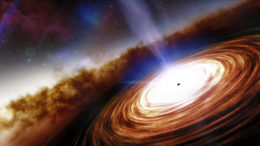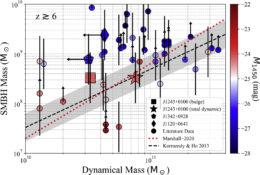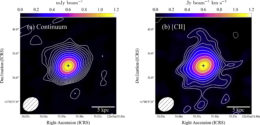Large galaxies host supermassive black holes at their centers. While studying these central black holes in nearby galaxies, we’ve discovered that the masses of the black holes can be tied to certain properties of their host galaxies. But is this still true for more distant galaxies, which we see as they were when the universe was younger?

Artist’s illustration of a distant quasar surrounded by a swirling, superheated accretion disk. [NOIRLab/NSF/AURA/J. da Silva]
Tying Black Holes and Galaxies Together
The observed relation between black hole mass and host galaxy properties is nothing to sneeze at! It suggests a particular evolution process for both the galaxy and its black hole, which could tell us about how galaxies even formed to begin with.
Notable galaxy properties that seem to be tied to black hole mass are stellar velocity dispersion — how stars move about the galaxy — and bulge mass, or the mass of stars densely clustered near the center of the galaxy. These properties both involve stars, and the most significant way a central black hole can impact star formation in its host is when it’s an active galactic nucleus, gorging on nearby material and spitting large amounts of energy out into space. When the black hole is in this violent phase, it can push star-forming material out of the galaxy and slow down star formation overall. But when and for how long do active galactic nuclei affect their galaxies like this?

Central black hole mass and galaxy dynamical mass — the mass of the galaxy as determined by its internal motion — for quasars at redshifts z ≥ 6, when the universe was just under a billion years old. The dashed and dotted lines are predicted relations between black hole mass and dynamical mass based on observations and simulations, respectively. Non-circular shapes correspond to J1243+0100 and two other quasars at similar distance. Click to enlarge. [Izumi et al. 2021]
Information from the Infrared
The galaxy in question hosts the quasar J1243+0100, which was identified in a Subaru Telescope survey. Quasars are the most active sort of active galactic nuclei, but J1243+0100 is one of the least energetic distant quasars ever observed. This means it might have settled into the state that produces the observed relation between black hole mass and galaxy properties.
J1243+0100 was discovered in optical observations, so to learn more about it Izumi and collaborators used far infrared observations taken by the Atacama Large Millimeter/submillimeter Array (ALMA). These observations were sensitive to broad infrared radiation from J1243+0100 and its host galaxy as well as a particular spectral feature called [C II], which is associated with carbon. The broad infrared radiation and [C II] can tell us about the internal motions of J1243+0100’s host and how rapidly stars are being formed.

ALMA observations of the broad infrared emission from J1243+0100 (left) and its [C II] emission (right). The black cross in both images is centered on the most intense broad infrared emission. [Izumi et al. 2021]
The bottom line is that the relation between central black hole mass and galaxy properties likely fell into place very early in the universe. Of course, only one object was covered in this study, but there are many other viable quasars that ALMA will observe in the future.
Citation
“Subaru High-z Exploration of Low-luminosity Quasars (SHELLQs). XIII. Large-scale Feedback and Star Formation in a Low-luminosity Quasar at z = 7.07 on the Local Black Hole to Host Mass Relation,” Takuma Izumi et al 2021 ApJ 914 36. doi:10.3847/1538-4357/abf6dc

